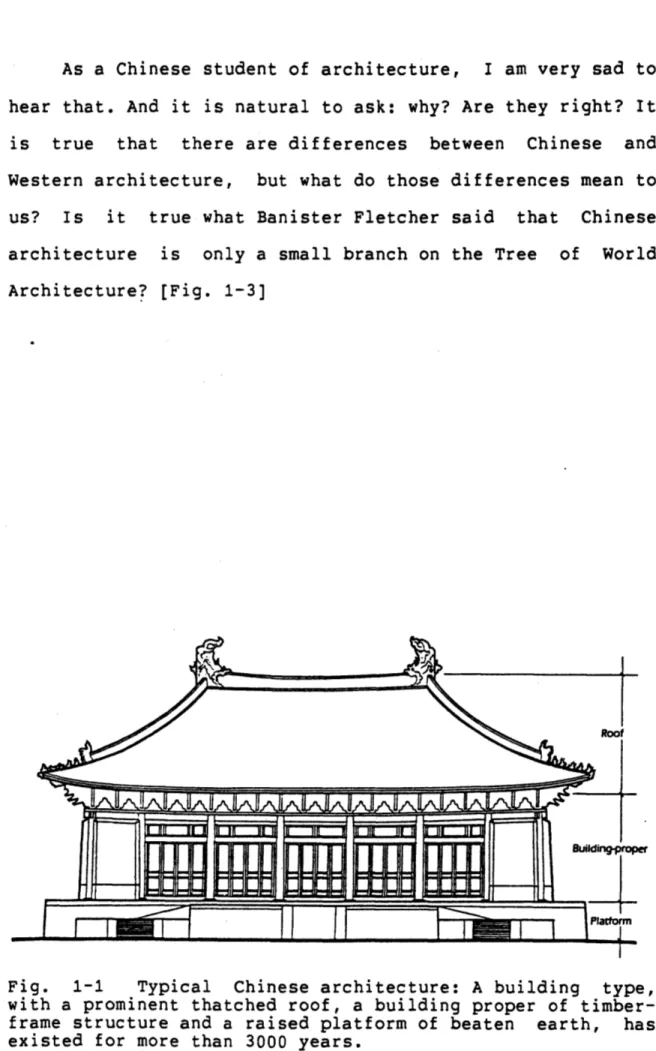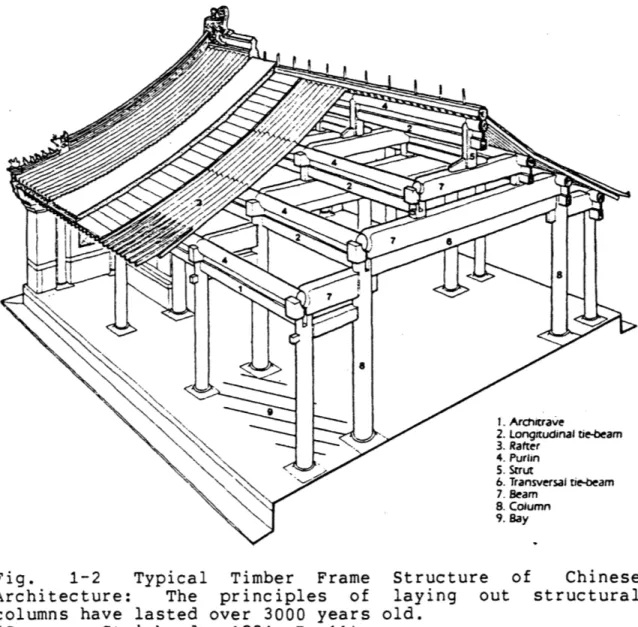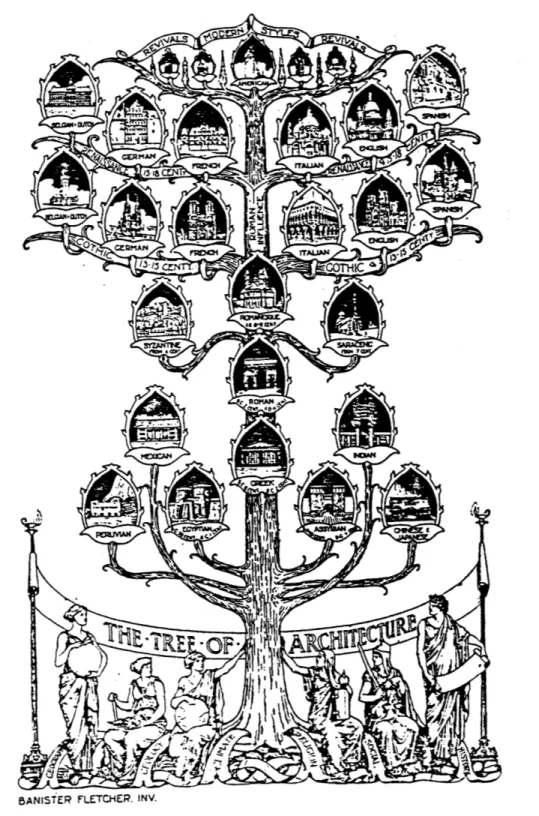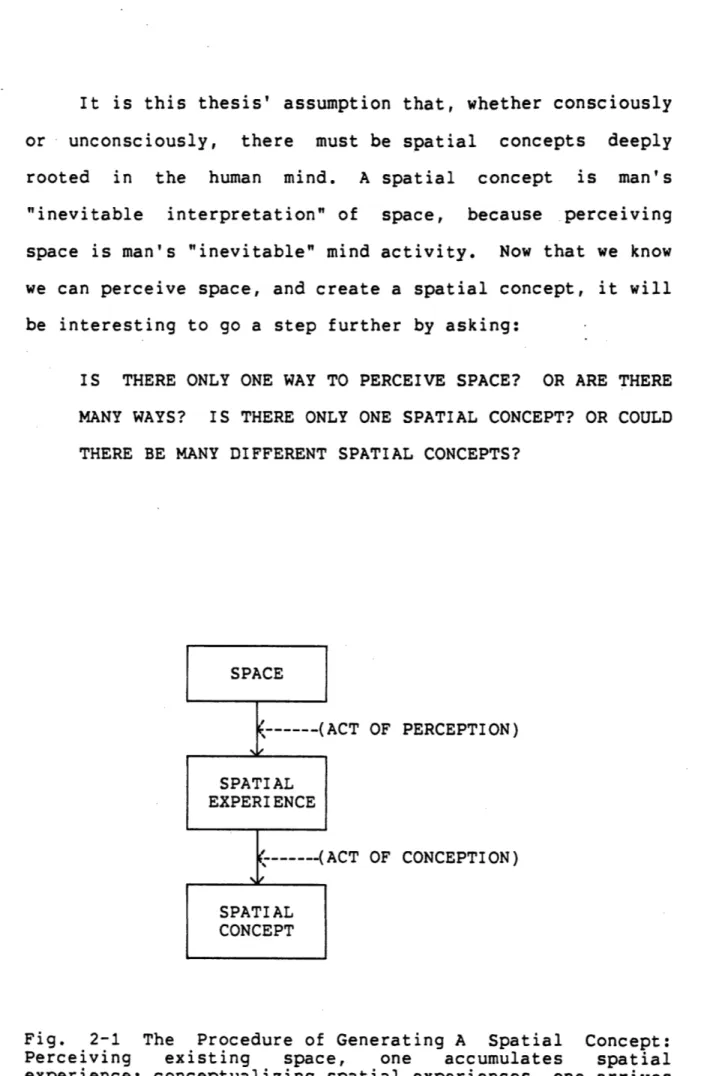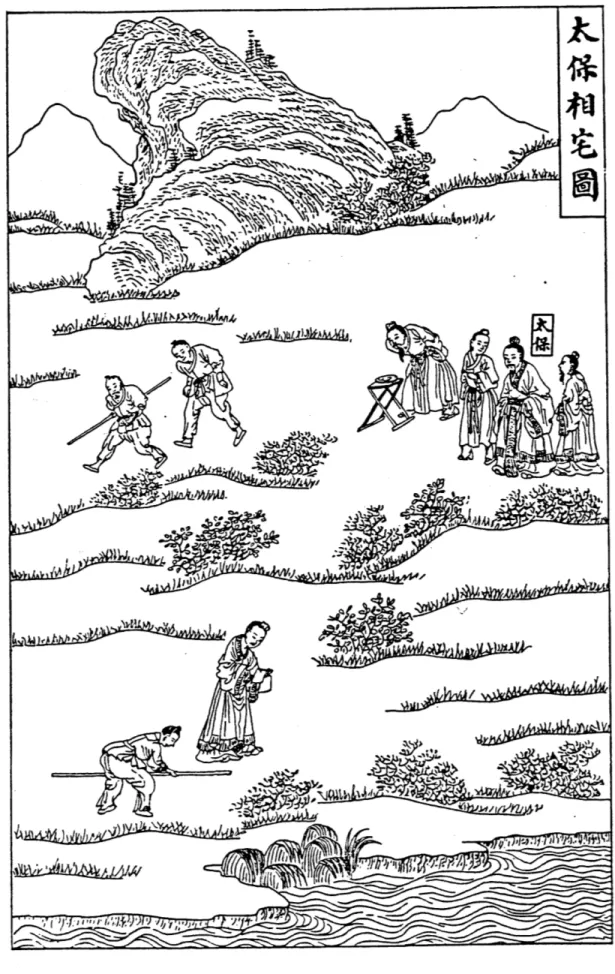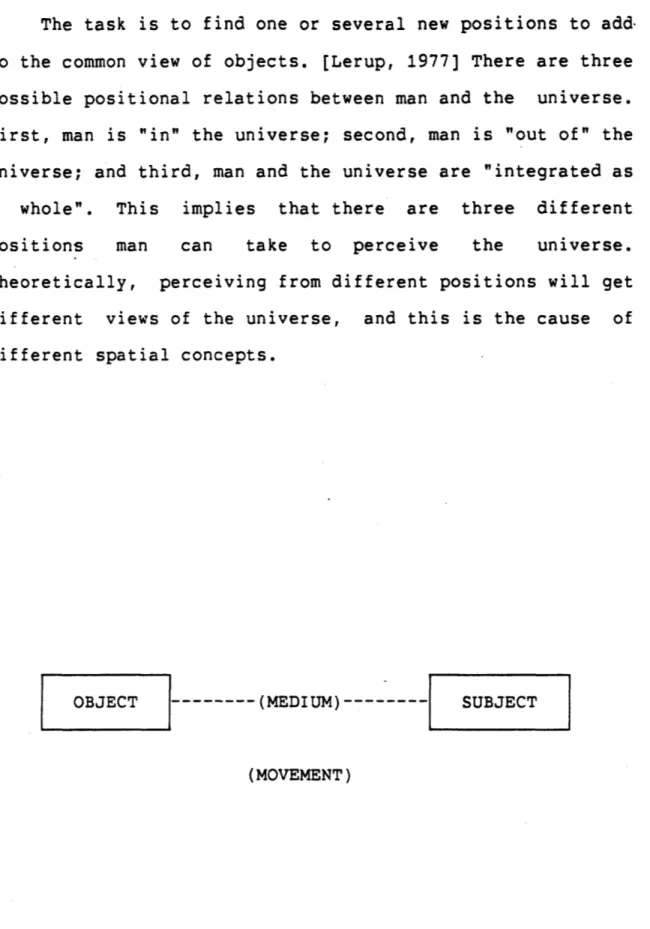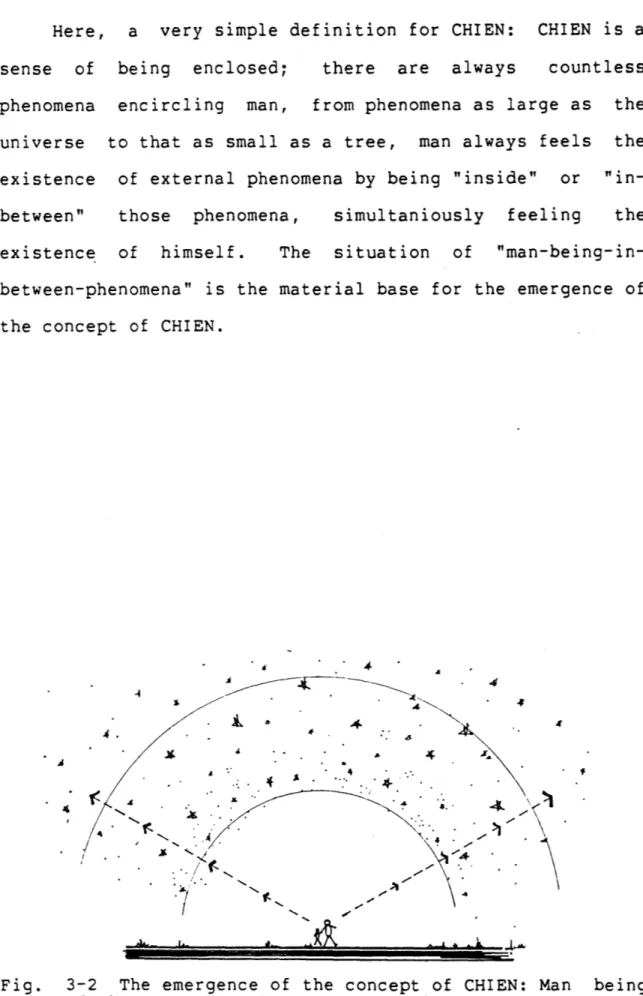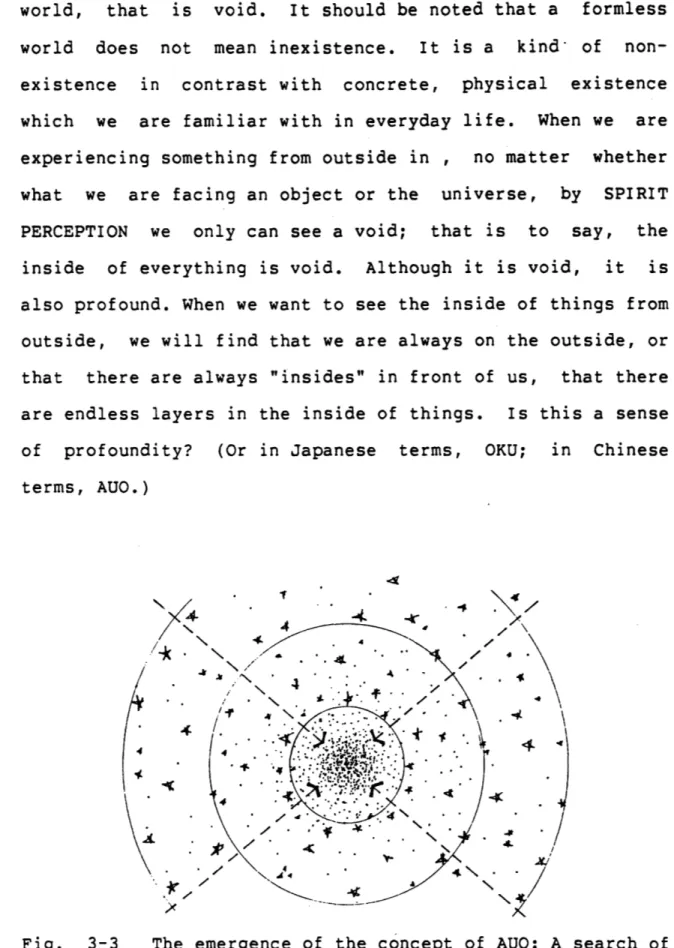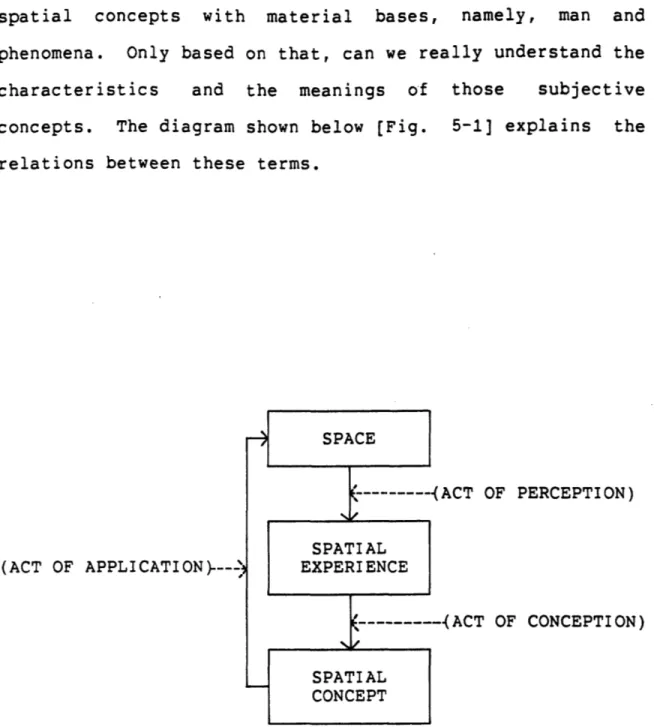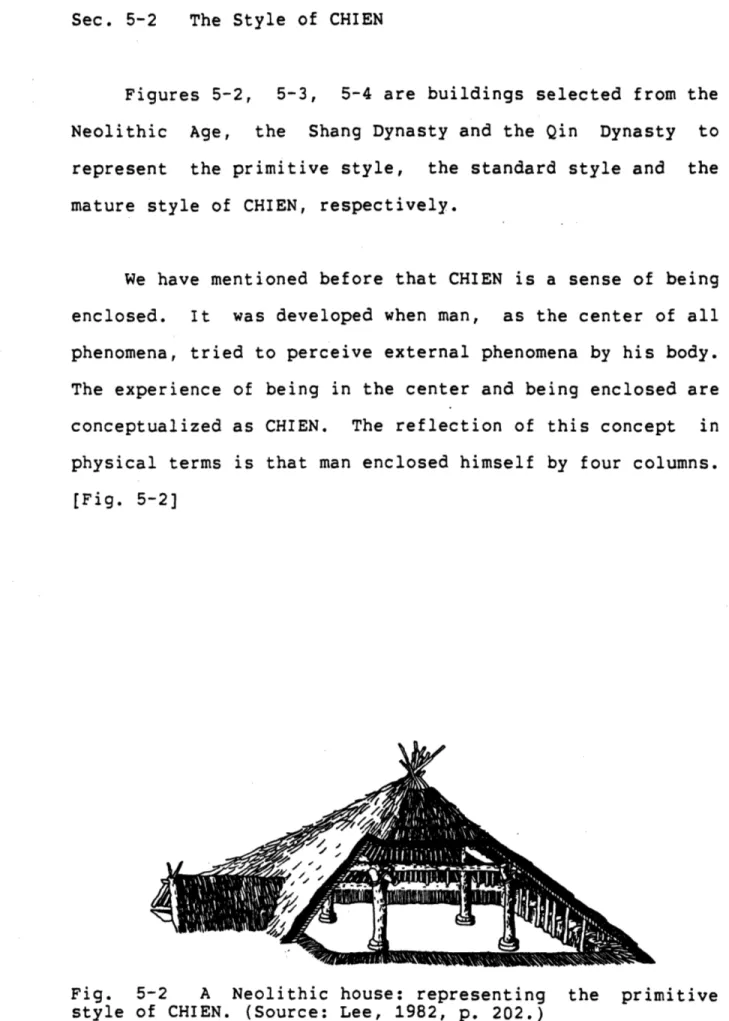CHIEN, AUO, SHIH:
EVOLUTION OF SPACE PERCEPTION AND SPACE MAKING IN CHINA
by Chih-Ta Lai
B.S. in Civil Engineering, National Taiwan University Taipei, Taiwan
June, 1981
SUBMITTED TO THE DEPARTMENT OF ARCHITECTURE
IN PARTIAL FULFILLMENT OF THE REQUIREMENTS OF THE DEGREE OF MASTER OF ARCHITECTURE AT THE
MASSACHUSETTS INSTITUTE OF TECHNOLOGY June, 1985
SChih-Ta
Lai 1985The Author hereby grants to M.I.T. permission to reproduce and to distribute publicly copies of this thesis document in whole or in part. Signature of author Certified by Accepted by Chih-Ta Lai Department of Architecture 'May 10, 1985 Gunter NitscFke / Lecturer Thesis Supervisor / Ju4 Messervy airperson Depa tmental Committee on Gra uate Students
ARCHIVES 1
CHIEN, AUO, SHIH:
EVOLUTION OF SPACE PERCEPTION AND SPACE MAKING IN CHINA by Chih-Ta Lai
Submitted to the Department of Architecture on May 10, 1985 in partial fulfillment of the requirements for the degree of Master of Architecture.
ABSTRACT
The question of "what is the essence of Chinese architecture" has been puzzling Westerners as well as Chinese since the inception of Traditional Chinese Architecture Studies five decades ago. This thesis attempts to answer the question by exploring some spatial concepts which have not been clearly documented before. Based on the exploration of those spatial concepts, a new historical perspective will be introduced to show succinctly how Chinese architecture evolved in the last 30 centuries.
The theoretical assumptions guiding the.thesis are: --- the emergence of spatial concepts is due to the fact of
man-always-having-to-perceive-spatial-phenomena,
--- the characteristics of spatial concepts are determined by the relationship between man and phenomena,
--- the relationship between man and phenomena may evolve, --- the evolution of spatial concepts makes up the history
of architecture.
Thesis Supervisor: Gunter Nitschke Title: Lecturer
CHIEN, AUO, SHIH:
EVOLUTION OF SPACE PERCEPTION AND SPACE MAKING IN CHINA
Architecture will be brought to its fullest realization when the deepest knowledge of human life as a total event in the biological whole is available. One of its important components is the ordering of man in space, making space comprehensibly by its articulation. The root of architecture lies in the mastery of the problem of space.
--- Laszlo Moholy-Nagy in The New Vision.
CONTENTS
Illustrations 7 Preface 8
Acknowledgement 9
Chapter I: Statement of Objectives 10 Chapter II: Space and Spatial Concept 19
Sec. 2-1: The Concept of CHIEN 25 Sec. 2-2: The Concept of AUO 29 Sec. 2-3: The Concept of SHIH 32 Chapter III: The Perception of Space 37
Sec. 3-1: Perceptual Model 40
Sec. 3-2: The Perception of CHIEN 44 Sec. 3-3: The Perception of AUO 47 Sec. 3-4: The Perception of SHIH 51
Chapter IV: The Evolution of Spatial Concepts 56 Chapter V: The Application of Spatial Concepts 66
Sec. 5-1: Perception and Application 69 Sec. 5-2: The Style of CHIEN 73
Sec. 5-3: The Style of AUO 79 Sec. 5-4: The Style of SHIH 82 Chapter VI: Conclusions 88
Sec. 6-1: Historical Arguments 90 Sec. 6-2: The Meaning of History 98 Appendix A: Chronology 102
Appendix B: Chinese Characters for Proper Names and Technical Terms 103
ILLUSTRATIONS
Fig. 1-1 Typical Chinese Architecture 13
Fig. 1-2 Typical Timber Frame Structure of Chinese Architecture 14
Fig. 1-3 The Tree of Architecture 15
Fig. 2-1 The Procedure of Generating A Spatial Concept 22 Fig. 2-2 Examining the SHIH of A Site 34
Fig. 3-1 Diagramatic Percetual Model 42
Fig. 3-2 The Emergence of the Concept of CHIEN 45 Fig. 3-3 The Emergence of the Concept of AUO 49
Fig. 5-1 The Procedure of Space Perception and Space Making 70
Fig. 5-2 A Neolithic House 73 Fig. 5-3 A Shang House 75 Fig. 5-4 A Qin House 77 Fig. 5-5 A Han House 78
Fig. 5-6 A Typical Chinese Courtyard House 79 Fig. 5-7 Courtyard Houses of Larger Scale 81 Fig. 5-8a Lin Garden 83
Fig. 5-8b The Perspective of the Lin Garden 84
Fig. 5-9 A Courtyard With A Pavilion in the Lin Garden 85 Fig. 5-10 A Typical Soochou Classical Garden 87
Fig. 6-1 A Prehistorical Settlement 92 Fig. 6-2 Ming-Tang of the Han Dynasty 93 Fig. 6-3 A Zhou House 94
PREFACE
It would be a long story to talk about the history of Chinese architecture, which has existed for over 3000 years, but every story can be abridged. To abridge is not only to mention key points quoted from a lengthy description, but to talk from a totally different angle to cover the complex phenomena by a few succinct concepts.
My study in this thesis has lasted for two years. The first draft of this thesis, which was written in Chinese, has been published in Chinese Architects (December, 1984). The major task of the study has been to find out an
"internal logic" embodied in the progress of Chinese architectural history. However, one should always keep in mind that the primary intention of this study is basically architecture-oriented, rather than history-oriented.
ACKNOWLEDGEMENT
I would like to thank those MIT architecture faculty who have inspired and helped me during my thesis study. They are:
Professor Gunter Nitschke, who inspired me in the very beginning of this thesis two years ago. Julie Messervy, who helped me to establish a reasonable struture for the writing of this thesis and patiently read my final draft. Professor John Habraken and William Porter, who have provided useful comments during the thesis preparation period. Mr. Ming H. Wang, who helped me especially in the theoretical criticism.
CHAPTER I
CHAPTER I
STATEMENT OF OBJECTIVES
First of all, I would like to explain my objectives by pointing out the meaning of this thesis to the field of Chinese architecture studies. The question of "what is the essence of Chinese architecture" has been puzzling Westerners as well as Chinese since the beginning of traditional Chinese architecture studies five decades ago. In this thesis I attempt to answer the question by exploring some spatial concepts which have not been clearly documented before. From the study of spatial concepts, I also attempt to establish an entirely new theory to open up a new view on the history of Chinese architecture. I am also going to challenge some conventional theories in the field of Chinese Architecture studies when the new view conflicts with the
old one.
You might ask: what is wrong with the conventional theories? Well, it is difficult to answer directly with just a few words. However, a brief comparison with Western architecture might be helpful in this early stage.
In Western history, the development of architecture is clearly illustrated by different styles of Greek, Roman, Romanesque, Gothic, Renaissance...and Modern architecture. There are indeed essential developments (of spatial experience) as well as stylistic improvements (of visual appearance). A package of terms has been invented to examine buildings, such as scale, proportion, dimension, massing, form, function..., etc. There is indeed a discipline of architectural theory.
Influenced by the theoretical studies of Western architecture, people used the same terminology to examine Chinese architecture, and found a "strange" phenomenon. In the studies of Chinese architectural history, it is widely recognized by scholars that, compared with the evident development of Western architecture, Chinese architecture, with strong images of prominent thatched roof, timber-frame structure system and raised platform of beaten earth, has not changed much in the past 3000 years. [Fig. 1-1, 1-2] In other words, Chinese architecture startles people not only by its "different" appearances (from Western architecture), but by its "continuity" of architectural characteristics. Some scholars even considered the continuity as a kind of "stagnation" and concluded that there is no discipline of architecture (compared with Western architecture) in ancient China.
As a Chinese student of architecture, I am very sad to hear that. And it is natural to ask: why? Are they right? It is true that there are differences between Chinese and Western architecture, but what do those differences mean to us? Is it true what Banister Fletcher said that Chinese architecture is only a small branch on the Tree of World Architecture? [Fig. 1-3]
Fig. 1-1 Typical Chinese architecture: A building type, with a prominent thatched roof, a building proper of timber-frame structure and a raised platform of beaten earth, has existed for more than 3000 years.
(Source: Steinhardt, 1984, p. 14)
Fig. 1-2 Typical Timber Frame Structure of Chinese Architecture: The principles of laying out structural
columns have lasted over 3000 years old. (Source: Steinhardt, 1984, P. 11)
BANISTER FLETCHER. INV.
Fig. 1-3 The Tree of Architecture:Is it true that Chinese architecture is only a small branch on the tree of World Architecture. (Source: Lee, 1982, p. 12)
All these are historical questions, and it is not easy to find out the factors which influence the progress of history. I have studied the history of Chinese architecture
for seven years and concentrated on spatial concepts, the subject of this thesis, for two years. Fortunately, I have found something interesting, which might change the conventional views of Chinese architecture and broaden our knowledge about architecture in terms of space perception and space making.
I think, examining Chinese architecture by using Western architectural theories is the cause of all confusions. This is a big mistake, because Chinese use a totally different perceptual means to examine their dwelling spaces. Generally speaking, Chinese are concerned with the intangible atmosphere created by physical elements, rather than those tangible elements. However, that is not to say that Chinese "preferred" intangible things to tangible, but that they "happened" to perceive primarily the intangibles, while Westerner happened to grasp the tangibles.
The visual as well as experiential difference between Western and Chinese architecture is obvious, but we still make mistakes. The misuse of theories is due partly to the advance of Western architectural theories and partly to the lack of systematic terminology which is suitable to describe the Chinese sense of space.
With this realization, I will try to pose a more fundamental question. If the objective and purpose of architectural research is to discover unknown properties of the physical environment, and FORM and FUNCTION are well-known properties of architecture, can we find more? Are there other unknown properties?
It is my intention and interest to develop a package of terms, similar to FORM and FUNCTION developed from the studies of Western architecture, for Chinese architecture. What I have found are three spatial concepts, namely CHIEN, AUO and SHIH. They reveal the experiential quality of Chinese architecture, which, I think, is what Chinese architecture can contribute to World architecture: the skill
of managing an intangible atmosphere.
Using the concepts of CHIEN, AUO and SHIH to examine Chinese architecture, I have also found that Chinese architecture has achieved a remarkable state of development in terms of the spatial organization of building clusters, while it has experienced less development in terms of the single building types.
Following this introduction, the thesis is divided into five chapters. In Chapter II, I will define the subject: space. I will also review some Chinese and Japanese views of space or spatial concepts. In Chapter III, I will explore the precise attributes of those spatial concepts by
reconstructing the "physical context" or "spatial situation", from which space might be perceived and conceptualized, and, in Chapter IV, try to reveal the evolutionary sequence of spatial concepts. Chapter III and IV are the major task of this thesis. The ideas presented are, in some aspects, original, which I feel are a breakthrough in the field of Chinese architecture studies. In Chapter V, I will use my theory to examine selected historical material to check whether the theory can explain the reality or not. Some conclusions will be drawn in Chapter VI.
Through my studies of spatial concepts in Chinese architecture, I wish to achieve a better understanding of the meaning of spatial concepts in architecture and the relationship between man and the physical environment, both are unfortunately ignored by modern architects.
CHAPTER II
SPACE AND SPATIAL CONCEPTS
2-1 The Concept of CHIEN
2-2 The Concept of AUO
CHAPTER II
SPACE AND SPATIAL CONCEPTS
Everybody will agree that there is only one physical environment, which is composed of visible solids, such as ground and mountains, and invisible voids --- space. The "reality" and "objectivity" of one physical environment is unshakable in today's scientific judgement. Man uses those visible solids, but can only "inhabit in" the invisible voids. Since space is the usable part of the physical environment, it becomes the major concern of all architects.
We know where and what space is; we know we can use it, we can even build man-made space within natural space. Yet, how do we know there is space? And how do we know what we can do in space? It seems everybody can "inherently". space. stupid answer It is
to ask such questions, because easily by saying that man knows man's inherent ability to perceive
To perceive space. That is the key point. We know there is space only because we can perceive it. We can do something in space because we are familiar with the properties of space. Laotzu had spoken:
"Moulding clay into a vessel, we find the utility in its hollowness;
Cutting doors and windows for a house, we find the utility in its empty space.
Therefore the being of things is profitable, the non-being of things is serviceable." [Chang, 1981, p.7.]
"This statement in relation to architecture suggests that the immaterial, that which is likely to be overlooked, is the most useful. Void, conventionally regarded as negative, actually is more important because it is always capable of being filled by solid." [Chang, 1981, p. 7.]
By perceiving space, we accumulate experiences about space. And then we conceptualize our experiences about space as spatial concepts, which is more valuable and applicable knowledge. This procedure of generating spatial concepts, including perceiving space and conceptualizing spatial experiences, might be simplified diagramatically as shown in Fig. 2-1.
It is this thesis' assumption that, whether consciously or unconsciously, there must be spatial concepts deeply rooted in the human mind. A spatial concept is man's "inevitable interpretation" of space, because perceiving space is man's "inevitable" mind activity. Now that we know we can perceive space, and create a spatial concept, it will be interesting to go a step further by asking:
IS THERE ONLY ONE WAY TO PERCEIVE SPACE? OR ARE THERE MANY WAYS? IS THERE ONLY ONE SPATIAL CONCEPT? OR COULD THERE BE MANY DIFFERENT SPATIAL CONCEPTS?
OF PERCEPTION)
OF CONCEPTION)
Fig. 2-1 The Procedure of Generating A Spatial Concept: Perceiving existing space, one accumulates spatial experience; conceptualizing spatial experiences, one arrives at spatial concepts.
Attractive questions, but no easy answer. We are now on the road to our adventure of creating a theory.
In this Chapter, I will review three very different spatial concepts. They are CHIEN, AUO and SHIH. The closest English translation of CHIEN is IN-BETWEEN; AUO is PROFOUNDITY; and SHIH is TENDENCY. However, all these translations are not adequate enough, and in order to avoid unnecessary misunderstanding, I will use the original terms, but readers may keep the closest English translation in mind.
I will be reviewing following materials:
1. Nitschke, Gunter. "MA: The Japanese Sense of Place" in Architectural Design, March 1966, pp. 117-156.
2. Isozaki, Arata. "MA: Japanese Time-Space" in The Japan Architect, February 1979, pp. 69-80.
3. Maki, Fumihiko. "Japanese City Spaces and the Concept of OKU" in The Japan Architect, May 1979, pp. 50-62. 4. Master of South Sea. Principles of Kan-Yu. Taipei,
Taiwan: Gee-Wen Bookstore, 1980.
Two points must be claimed and clarified before we go ahead. First, although this is a study of Chinese architecture, some Japanese materials are included. The achievements of Chinese architecture studies are still rather limited, while Japanese architecture studies have some useful points of view which provide very valuable hints for this thesis. And because Japanese architecture is a
branch of Chinese architecture in terms of spatial concepts, I think it will be reasonable and acceptable to include Japanese materials in this study. For example, MA, appearing in Gunter and Arata's articles, is the Japanese version of Chinese CHIEN. They are exactly the same when written in Chinese characters. And OKU, appearing in Maki's article, is exactly the same with Chinese AUO when written in Chinese characters. There might be some variations of pronounciation and usage, but the essential meanings do not change much.
Second, it is understandable that Japanese scholars will deny the identities between MA and CHIEN, and between OKU and AUO. Although it has a very close cultural bond with China, Japanese scholars usually tend to ignore, consciously or unconsciously, that fact, and always claim the originality of Japanese culture. However, in this thesis I am not going to get involved in this kind of international embroilments, but make some assumptions and, based on that, develop my own ideas.
Sec. 2-1 The Concept of CHIEN
It is Professor Gunter Nitschke's article, entitled "MA: Japanese Sense of Place", which inspired me in the very beginning of this study. That was the first time I had realized that a simple word like MA could be a philosophical concept. Besides Professor Nitschke's article, I have also found that Kisho Kurakawa and Arata Isozaki, both famous Japanese architects, had claimed that it is the concept of MA which has shaped the unique character of the Japanese physical environment. Isozaki had even held exhibits in Paris and New York introducing MA and its applications in architecture and everyday life.
No matter what MA is, we realize that it is a very important and powerful concept in some people's eyes. Yet, what is MA? What makes MA so attractive? Let us review some of points made by its exponents.
Professor Nitschke's description of MA deserves mention especially when he tries to explain the attributes of MA
from a Western viewpoint to Westerners. He says:
"Japanese sense of MA is not something that is created by compositional elements; it is the thing that takes place
in the imagination of the human who experiences these elements. Therefore one could define MA as 'experiential' place..."
"Japanese sense of place is MA, best described as a consciousness of place, not in the sense of...an enclosed three-dimensional entity, but rather as...places of central activities."
"So I speak of space in the traditional Western three-dimensional sense, the obverse of substantial, tangible objects. As a box viewed from the outside is an object, so the inside is space." [Nitschke, 1966]
Nitschke's introduction reveals a very fundamental difference between Western and Japanese spatial concepts. The "experiential" space of Japanese culture represented by MA is interesting, but what it really means is still
unclear.
Nitschke introduced MA from the Western point of view. What will a Japanese say about MA? Let me quote some of
Isozaki's sayings.
"Briefly speaking, MA is a conceptualization of both space and time and means, in spatial terms, the natural distance between two or more things existing in a continuity or the space delineated by posts and screen (that is, room) or, in temporal terms, the natural pause or interval between two or continuously." [Isozaki, 1979]
It seems to me that MA as a concept concerns the abstract relations "between" two things. This preliminary understanding is rough, but we are deeply attracted. This also reminded me that the meaning of Japanese MA is very similar to that of Chinese CHIEN. In fact, when written in Chinese characters, Japanese MA is exactly the same as Chinese CHIEN. It will be interesting to know what is CHIEN? How do a Chinese see CHIEN? Is it also a kind of concept concerning space?
CHIEN is indeed a kind of spatial concept in Chinese architecture. The meaning of CHIEN is exactly the same as what Nitschke and Isozaki said about MA.
Not only in Chinese architecture, but in everyday language, Chinese speak of CHIEN a lot. To mention some of them: CHUNG-CHIEN (middle), KON-CHIEN (space), SHI-CHIEN (time), CHEN-CHIEN (morning), WU-CHIEN (noon), WAN-CHIEN (night), YING-CHIEN (nether world), YANG-CHIEN (man' world), JEN-CHIEN (man's world)...
All these words with a CHIEN in it concern a kind of specific domain or territory, either physical or abstract. And the intervention of the human body is the means to experience CHIEN.
However, CHIEN, or MA is not the only experiential space. Besides them, we will be reviewing other experiential spaces of different characteristics. Keep in minds that we will shift our attention to another interesting concept
The Concept of AUO
The second concept which attract me is also introduced by Japanese. The famous Japanese architect Fumihiko Maki's article "Japanese City Spaces and the Concept of OKU"
inspired me in this stage. The following are quotations from his article:
"OKU is a sense of penetrating the layers of an onion. It implies something abstract, profound, innermost, extending far back, least accessible and deep. OKU is the original point (mental touchstone) in the minds of the people who observe or create it, and hence becomes the invisible center. It is a convenience devised by a spirit which deny absolute objects or symbols as the notion of center. OKU is nothing but the concept of convergence to zero."
"One notices further how abundant the Japanese language is in words modified by the adjectival OKU. Among spatial concepts, one can begin with explicit expressions such as OKU-GUCHI (rear entrance), OKU-YUKI (depth), OKU-YAMA (recesses of a mountain), and OKU-ZASHIKI (inner parlor) and continue on to expressions that are the social affirmations of such relationships: OKU-DEN (hidden mysteries of an art), OKU-GI (secret principles); these are invisible but exist
implicitly, and OKU-NO-IN (inner temple), OKU-GATA (wife of an aristocrat or nobleman), which suggest a hidden but
29
powerful position in society." [Maki, 1979]
It seems to me that OKU concerns the "inside world" of things. There is also a very strong sense of "directionality", leading to "back", "deep", "inner", "hidden", in all expressions relating to OKU, which are not found in the case of CHIEN (or MA), which only expresses a sense of void between things.
It is also interesting to notice that, when written in Chinese characters, OKU is exactly the same as AUO. This coincidence, like the situation in MA and CHIEN, leads me to review Chinese thoughts regarding AUO. There are some words relating to AUO in Chinese everyday language. To mention some of them: AUO-MI (mystery), AUO-MIAU (mystery), SHEN-AUO (profoundity), TANG-AUO (deep reality).
Among them, TANG-AUO is especially noticeable. In Chinese architecture, both TANG and AUO signify rooms. AUO
is the room behind TANG. When one enters a house, he will be in TANG, the main room, first. After entering TANG, members of the family or close friends may go further into AUO; outsiders can only feel the space of AUO behind TANG, but cannot enter it without permission. The relation between TANG and AUO indicates a sense of depth and mystery, similar to the Japanese OKU.
Imagination is the means to sense it. It is important to note that the human body cannot possibly to get into the inside of solid things, thus man has to use a different way to sense the inside world of things.
Sec. 2-3 The Concept of SHIH
It is interesting to note that, compared with Japanese architects, Chinese architects seldom talk about CHIEN and AUO, although those concepts are originally Chinese. It does not mean that Chinese do not have the concepts of CHIEN or AUO, but on the contrary, that CHIEN and AUO had existed in China for a long time and eventually they faded away. Roughly speaking, since the Song Dynasty (11th century), Chinese have shifted their interest to another concept, namely SHIH.
Chinese treat SHIH just like Japanese do OKU (or in Chinese term, AUO). Abundant words relating to SHIH can be
found in everyday language. To mention some of them:
When observing natural phenomena, Chinese tend not only to name those phenomena, but to describe the "general atmosphere" of those phenomena. For example, facing a mountain, Chinese do not just say that it is a mountain, but
tend to describe the SHIH of the mountain. We tend to say the "MOUNTAIN-SHIH" is so and so, which might be great, smooth, steep, complex, chaotic, etc. Mountain has MOUNTAIN-SHIH, of course ground has GROUND-MOUNTAIN-SHIH, wind has WIND-MOUNTAIN-SHIH, rain has RAIN-SHIH, fire has FIRE-SHIH, water has WATER-SHIH ....
Not only in observing natural phenomena, but in other sorts of phenomena, Chinese use SHIH a lot. In a combat situation, we can observe the SHIH of offending or defending (OFFENSE-SHIH, DEFENSE-SHIH) and see who is in BETTER-SHIH and who is in WORSE-SHIH.
Generally speaking, SHIH seems to imply an understanding of a changing situation, a growing force, a developing tendency. It is a "holistic view" of the external
phenomena. This holistic view is very different from the stability of CHIEN and the directionality of AUO.
There is no doubt that SHIH is a very popular way of describing things by the Chinese. But what is SHIH? What does it really mean? Unfortunately, we know very little about it from the point of view of architecture. However, we can find some uses by geomancers.
The concept of SHIH is widely used in Chinese geomancy. Let me quote some words from the Master of South Sea's book,
"Principles of Geomancy", to explain what SHIH is.
"The main concern of Chinese geomancy is FORM-SHIH. To build a settlement, no matter whether as large as a city, or as small as a house, the first thing to do is to examine the FORM-SHIH of the site. Where the best FORM-SHIH is located is the site.. So-called FORM-SHIH is determined by the distribution of mountain and water. Because the relations
Fig. 2-2 Examining the SHIH of A Site:
between mountains and water have various possibilities, there are "dispersed" or "gathered" distributions, which will in turn determine its adaptability as a site for a city, a town, a village, a house, or most important, a tomb." [Fig. 2-2]
What interests me is the way FORM-SHIH is qualified, namely as "dispersed" or as "gathered". These are two different, but complementary terms. Without "gathered", there will be no "dispersed", and vice versa. The two form a pair. There are many of this kind of pairs in geomancy, such as "dark-bright", "dynamic-static", "along-against", "solid-void", "rigid-tensile", "quick-slow", "lasting-ephemeral",
etc. All these contrasts are used to describe SHIH.
It hints at a sense of flowing, growing and interacting. It describes any phenomenon with force, energy and tendency. Everything is perceived as "alive" and dynamic.It seems that SHIH concerns the changing rhythms, rather than the static characteristics of the universe. It reflects a holistic view of the universe.
"Chinese city planners were well aware that the fortunes of a city could be assured only if its sites were adapted to the local currents of the cosmic breath, namely ch'i. These local influences (FORM-SHIH), the dynamic powers of the genius loci, were modified from place to place by the morphology of terrain and from hour to hour by the
dispositions and conjunctions of heavenly bodies. The analysis of the morphological and spatial expressions of ch'i in the surface features of the earth constituted the pseudo-science of feng-shui, the art of adjusting the features of the cultural landscape so as to minimize adverse influences and derive maximum advantage from favorable conjunctions of forms."
CHAPTER III
THE PERCEPTION OF SPACE
3-1 Perceptual Model 3-2 The Perception of CHIEN
3-3 The Perception of AUO 3-4 The Perception of SHIH
CHAPTER III
THE PERCEPTION OF SPACE
In the last chapter, we reviewed three different spatial concepts, which were impressive by their simplicity as well as complexity. They are simple because every concept is represented by a single word. They are also complex because that single word means a lot and is deeply integrated into ordinary people's everyday life. They are intellectually exciting, but yet not totally satisfying. My own dis-satisfaction emerged especially when I try to compare one with the other in terms of the physical environment.
Because the definitions of these spatial concepts are not precise enough, there are inevitable contradictions between them when they are applied to historical examples. We especially want to know:
WHERE ARE THESE SPATIAL CONCEPTS FROM? HOW ARE THEY REALIZED? WHAT DO THE DIFFERNECES BETWEEN CONCEPTS MEAN TO US?
In order to answer these questions, we have to further explore the essential attributes of every spatial concept. We know that a spatial concept is man's subjective, abstract interpretation of space. The reconstruction of the spatial or physical "context", from which the spatial characteristics of CHIEN, AUO and SHIH might be derived, becomes necessary. The reason for reconstructing the physical context of a perceptual situation is based on the assumption that
THE EMERGENCE OF ANY ABSTRACT CONCEPT IN THE HUMAN MIND WOULD NOT BE POSSIBLE UNLESS THERE IS A "CONCRETE CONTEXT", WHICH IS THE FUNDAMENTAL "MATERIAL BASE" OF HUMAN PERCEPTION AND WHICH WILL DETERMINE THE ESSENTIAL ATTRIBUTES OF THE CONCEPT.
Sec. 3-1 Perceptual Model
The physical environment, time, and man "exist" naturally and inseparably. They are the fundamental phenomena of the universe. They are given. The relations between them can be simply stated as MAN EXISTS CONTINUOUSLY IN THE PHYSICAL ENVIRONMENT. This simple fact has also been explored by the Western philosopher Heidegger.
"Heidegger's point of departure is his concept of man as Being-in-the-World. This implies on the one hand that man cannot be understood in isolation from his 'environment', and on the other that our understanding of the world is always related to man." [Norberg-Schulz, 1979]
Realizing the integrative relations between man and the physical environment, and realizing that man is the only origin of that understanding is important. Based on this understanding, we try to construct the theoretical physical situations which illustrate the emergence of spatial concepts.
The physical situation is defined specifically in this thesis as the "positional" and "perceptual" relationship between man and the physical environment, or in a more general term, the phenomena.
Because space is the integral part of the universe, the method I will use for the reconstruction in this particular thesis is to study the relation between man and the universe, particularly concentrating on how man perceives the universe? From where? By what means?
I believe that the way we create space is completely the same as the way we perceive space. The relationship between creation and perception of space is that
"MAN CONCEPTUALIZES WHAT HE PERCEIVES FROM EXISTING SPACES TO GENERATE A KIND OF SPATIAL CONCEPT, WHICH WILL IN TURN DOMINATE HIS CREATION OF SPACE.
For a meaningful perceptual model, there must be 1. a perceptual subject,
2. a perceptual object, 3. a percetual medium, and 4. a perceptual move.
Their relations could be illustrated diagramatically as the one shown in Figure 3-1. The perceptual subject is of course man himself. The perceptual object is, in general, various phenomena, in particular, the universe. The perceptual medium refers to the senses of the human body, which works like the tool of thinking. The perceptual move is man's actual way of perceiving.
The task is to find one or several new positions to add. to the common view of objects. [Lerup, 1977] There are three possible positional relations between man and the universe. First, man is "in" the universe; second, man is "out of" the universe; and third, man and the universe are "integrated as a whole". This implies that there are three different positions man can take to perceive the universe. Theoretically, perceiving from different positions will get different views of the universe, and this is the cause of different spatial concepts.
OBJECT --- (MEDIUM)--- SUBJECT
(MOVEMENT)
Fig. 3-1 Diagramatic percetual model:Subject refering to man; object refering to any phenomenon (external or internal); medium refering to the senses of human body; movement refering the perceptual direction.
It is understandable that man is "in" the universe, but, how can man be "out of" the universe? And how can man be "integrated with" the universe? These positions obviously violate our common sense. What are those situations?
Well, I think, it is a problem of perception, or more precisely, a problem of perceptual skill. To perceive the three different relations between man and the universe, man of ancient China had developed three different perceptual skills, which in a very fundamental sense determine the essential attributes of spatial concepts.
Sec. 3-2 The Perception of CHIEN
Simply speaking, CHIEN is the concept arrived at when man experiencing "external" phenomena. The perceptual medium is the physical BODY. The perceptual move is "from inside out". According to the perceptual model mentioned above, its various parameters may be listed as follows:
1. Perceptual subject: man;
2. Perceptual object: external phenomena; 3. Perceptual mediem: the body; and
4. Perceptual move: from inside out.
Obviously, this is a very rough and subjective statement. It is not arrived at deductively. Rather, it is my hypothesis.
Facing the huge firmament and enormous stars, "how" would you grasp the greatness of the universe? I believe that many of us must have had the experience of perceiving the starry sky by extending the "boundary" of our body into the sky in a cloudless night. We may not be able to count precisely how many stars there are, but we can use our senses to grasp the existence of the universe. [Fig. 3-2]
Experiencing by the body, we feel the sky as an upside-down bowl; and man is covered "inside". Is this a sense of being inside, or in more general terms, being "in-between"?
Here, a very simple definition for CHIEN: CHIEN is a sense of being enclosed; there are always countless phenomena encircling man, from phenomena as large as the universe to that as small as a tree, man always feels the existence of external phenomena by being "inside" or "in-between" those phenomena, simultaniously feeling the
existence of himself. The situation of "man-being-in-between-phenomena" is the material base for the emergence of
the concept of CHIEN.
Lb b 44. 6· 4 f 4 AA i.
Fig. 3-2 The emergence of the concept of CHIEN: Man being enclosed by external phenomena; man is the center, the origin, of everything; divergent perception.
~-Y· I .. ---sl 1 - -L L S L ! ·
Furthermore, we also can say that CHIEN is the concept of experiencing external phenomena by the human body; it grasps all objective, concrete, absolute, static relations existing in the phenomena. And because man observes the external phenomena from himself, it is natural that man would tend to see himself as the center of all external phenomena. All views of phenomena are therefore from the center out, which we can simply call "divergent".
The Perception of AUO
Simply speaking, AUO is the concept arrived at when man experiencing "internal" phenomena. The perceptual medium is the SPIRIT. The perceptual move is "outside in". According to the perceptual model mentioned above, we may
isolate the following parameters:
1. Perceptual subject: man;
2. Perceptual object: internal phenomena; 3. Perceptual medium: the spirit;
4. Perceptual move: from outside in.
In the concept of CHIEN, the relationship between man and external phenomena is one of man being enclosed by external phenomena and developing a divergent perceptual skill, namely BODY PERCEPTION. Now, for the emergence of AUO, we try to think in a totally different way, that is, man escaping from the enclosure of external phenomena and trying to observe internal phenomena from the outside. [Fig. 3-3] Undoubtedly, this is a totally new view, even though we still do not know what it is? How to grasp it?
The famous poet Li Pai of the Tang Dynasty has written this well-known poem:
"I don't know the real appearances of Lu Mountain, I just feel being in the Mountain."
This poem expressed man's situation of losing himself in the "inside" of external phenomena and also man's desire to see the "whole appearance" of external phenomena, which is obviously impossible when being inside.
It seems obvious that if one really wants to see the whole appearance of a mountain, the only way to do it is to leave the mountain and look back from outside. If what one wants to see is not just a mountain but the whole universe, the situation becomes tough. The problem is simply how can man escape from the universe? I think, that is purely a
technical problem of perceiving.
It is true that the physical body of man can not escape from the earth (not to mention from the universe), but can the spirit of man. The spirit is a kind of abstract "spiritual status"; man can manipulate his own mind into that spiritual status to get rid of the constraints of the physical body in order to travel spiritually to any place
which is out of the reach of the physical body -- in our case the outside of the universe -- and then the whole appearance of the universe becomes graspable. We tentatively
call this way of seeing things as SPIRIT PERCEPTION-.
If SPIRIT PERCEPTION can help us to get a new view of things, then, how to get into such a spiritual status? How to do SPIRIT PERCEPTION? Simply speaking, through meditation. By meditating, one can get into an formless
world, that is void. It should be noted that a formless world does not mean inexistence. It is a kind' of non-existence in contrast with concrete, physical existence which we are familiar with in everyday life. When we are experiencing something from outside in , no matter whether what we are facing an object or the universe, by SPIRIT
PERCEPTION we only can see a void; that is to say, the inside of everything is void. Although it is void, it is also profound. When we want to see the inside of things from outside, we will find that we are always on the outside, or that there are always "insides" in front of us, that there are endless layers in the inside of things. Is this a sense of profoundity? (Or in Japanese terms, OKU; in Chinese terms, AUO.) . . . - 7 1 -\\ 4 4 A A/\ P7.\ 4;"
4eI
Fig. 3-3 The emergence of the concept of AUO: A search of internal world; man's thinking is converging to a formless center without a specific origin, a situation completely different from, but complement to, that of CHIEN.
One may say that it is also possible to see the inside of things, say an orange, by cutting part of it off to expose the inside. But the point is that, after being exposed, it is no longer the inside. The inside we are looking for is the inside which can not be exposed materialistically.
Generally speaking, AUO is a sense of profoundity conceptualized when one tries to grasp the inside world of things through SPIRIT PERCEPTION.
The Perception of SHIH
Briefly speaking, SHIH is the concept arrived at when man experiencing external as well as internal phenomena. The perceptual medium is the BREATH. The perceptual move is the reciprocal flow between inside and outside. According to the perceptual model mentioned above, its various parameters may be listed as follows:
1. Perceptual subject: man;
2. Perceptual objcet: external and internal phenomena; 3. Perceptual medium: the breath;
4. Perceptual move: the reciprocal flow.
Up to now we have seen two ways of experiencing phenomena, namely, "from inside out" and "from ouside in". Next we will go further to see what kind of situation is available for the emergence of SHIH.
Through BODY and SPIRIT PERCEPTIONS, we have travelled from inside out and from outside in, and invented the concept of CHIEN and AUO, respectively. It seems that since we have already covered all possibilities; where else can we go? What kind of relation between man and phenomena is still available to support the emergence of SHIH? There is still one relationship between man and phenomena which is totally different from the previous two; in that relationship
MEN AND PHENOMENA ARE- NO LONGER TWO INDEPENDENT
SUBJECTS, BUT AN "INTEGRATED ENTITY"; THERE IS NO DISTINCTION BETWEEN MAN AND PHENOMENA, AS INSIDE AND OUTSIDE, RESPECTIVELY.
This is an assumption also logically acceptable, and it is the only one we can find for SHIH.
Leaving aside the question of "why" man and phenomena should be integrated, we just want to ask: "how" can man and phenomena be integrated? Objectively, we can not deny the distinction between man and phenomena, and we also can not ignore that fact. What we can do is to integrate them subjectively. Of course we understand that it is impossible to change objective facts by subjective thinking, but we can give objective facts different "meanings" by subjective thinking. So, what we are going to do is to create the "meaning of integration", rather than to create the facts of integration, between man and phenomena. Just like in the emergence of the concept of AUO, man can subjectively get rid of the constraints of his physical body in a spiritual state, but can not change the fact of the existence of the physical body.
I think that integrating man and phenomena is also purely a technical problem of perceiving. The key to integrating man and phenomena is that of finding out an appropriate perceptual medium and "inventing" an appropriate
perceptual skill. I think, ch'i (or BREATH) used by Chinese geomancers is the key to solve this problem.
We have mentioned in Section 2-4 that ch'i is an "abstract material" which is the basic compositional element of all natural phenomena including man. One may try to
imagine it as an equivalent of configurational energy in physics. Now, if ch'i is the basic compositional element of everything, then can man and phenomena be integrated by ch'i? Theoretically, it seems a reasonable assumption. Let us go further.
Following the means of inventing SPIRIT PERCEPTION in the previous section, let us think about inventing CH'I PERCEPTION or BREATH PERCEPTION. Let us start from the simplest fact that "everyone-can-and-must-breathe". Breathing includes two complementary steps, namely breath flowing from inside of the body out and from outside of the body in. If we can consciously sense the feeling of breathing in and out, then we will control one more way to experience phenomena.
We know that breath is the symbol of life. Strong breath means strong life; no breath means no life. Similarly, if man subjectively imagines a flow of breath into a phenomena, that phenomena will become "alive"; on the contrary, a phenomenon without breath is dead, even though it exists objectively.
Thinking about these words, "man", "breath", "phenomena" and "alive", a little bit more, we may assume that: when man consciously and subjectively controls his own breath and conducts it flowing into a phenomenon, that phenomenon will become "alive", and the communication of breath between man and the phenomenon will integrate them
in terms of life, that is to say, man and the phenomenon could be integrated in terms of life by breath. This integration will be possible only through the flow of breath between man and phenomena; therefore we will name this skill as BREATH PERCEPTION.
The next problem is what are the characteristics of BREATH PERCEPTION? What kind of "view" can it give us? To answer this question, we must understand the feeling of breathing more precisely. Besides pertaining to life, breathing also can influence the way we think. For example, breathing in and out could be the base of a two-way thinking; breath is flowing continuously, but it could be
stopped, so "flowing" and "stopping" is another pair of characteristics which give a sense of "dynamic" and
"static"; Breathing could be stopped after breathing in or after breathing out, in the former case our body is filled with breath which gives a sense of "gathered", in the latter our body is empty which gives a sense of "dispersed"; breathing could be "quick" and "slow", could be "deep" and
"shallow", could be "long" and "short", etc. All these contrasts and their combinations can influence our way of
thinking very much.
Payint attention to breathing, one will find more features, such as "Dynamic-static", "rigid-tensile", "gathered-dispersed", "acting-reacting", "separated-united", "floating-sinking", "along-against", "lasting-ephemeral", "void-solid", "strong-weak", "quick-slow", "dim-bright", "forward-backward"....
The general Chinese term to include all of these is YING-YANG, which is well-known in Western culture. However, all characteristics included by YING-YANG could be represented again by a single word, that is SHIH. SHIH represents a view of the universe which embraces all contradictions and paradoxes of the world.
CHAPTER IV
CHAPTER IV
THE EVOLUTION OF SPATIAL CONCEPTS
The previous studies of the physical situations and perceptual skills for the emergence of spatial concepts give us the physical definitions of CHIEN, AUO and SHIH. The model we used was to re-construct the physical relationship between perceptual subject and object, namely, man and phenomenon. We have found that there could be three different positional relations between man and phenomenon, however, we have not noticed "why and how man knows these
three possibilities". The question is:
Did man already inherently know those three different possibilities in the very beginning and freely make his own choice of perceiving phenomena in a particular way? Or, following the increasing
understanding of phenomena and himself, did man "gradually" and "sequentially" realize the various possible relations between man and phenomena?
Intuitively, we believe that the emergence of spatial concepts is a process of learning, of trial-and-error. That means that we tend to accept the latter possibility. However, to answer these questions, we must go deeper into
the relations between the three concepts.
Because different spatial concepts are the result of perceiving phenomena from different positions, with different perceptual media, by different perceptual moves, it might be helpful to question "how they differ from each other?"
The idea coming up in my mind is caused by an intuitive feeling that it seems that CHIEN, AUO and SHIH are not three different, independent spatial concepts, but represent three consecutive stages of the same perceptual tradition. In other words, it seems that there is an evolutionary relationship between CHIEN, AUO and SHIH.
Following the previous question, if all concepts do not appear at the same time, then which one would appear first? Which would be second? And which one the third?
I suspect that CHIEN is the first spatial concept that appeared in Chinese history; AUO is the second and SHIH is the third. If this suspicion was true, it would change all conventional theories of Chinese architecture. In the following paragraphs I will try to find the "internal logic"
behind the evolution of spatial concepts.
To explore this problem, we still have to go back to the basic relation between man and phenomena, because all these problems originate from the inevitable fact:
MAN HAS TO PERCEIVE SPACE.
I think, man actually has no choice. In the very beginning, man can only perceive the universe from the inside; at that time, man did not have the idea of an outside. This is because man is objectively enclosed by phenomena. This is a natural fact, rather than a situation chosen subjectively by man. This just like a new-born who can only perceive the existence of the external world, but has no idea about himself. The situation for man's perception of phenomena is theoretically the same.
Perceiving from the inside out without any idea of the outside is the primitive stage of perception, which is also the beginning of man's perceptual history. According to the last chapter's studies, the first perceptual skill having ever been invented should be BODY PERCEPTION. Of course, from experiencing unconsciously the existence of a phenomenon to perceiving it consciously, there is great distance. BODY PERCEPTION did not appear suddenly and automatically, but was developed gradually by man. It was man's subjective invention. The result of BODY PERCEPTION is
the emergence of the concept of CHIEN.
Theoretically, a mature and perfect concept at the philosophical level must be able to explain all phenomena. Today we can easily fing the shortcomings of CHIEN, but our ancestors might not have been so able. Even after they realized the shortcomings of CHIEN, they found it impossible to immediately develop a new concept to replace or complement the old one. To break through the limitation of BODY PERCEPTION, man has to observe, to imagine, to think, and to invent. It takes time for the growth of man's knowledge, for the coming of a breakthrough. However, man will ultimately improve on every unsatisfactory situation.
Following the concept of CHIEN, AUO appeared. Of course, it was also invented by man, rather than appearing
from nowhere. I think it was in the concept of CHIEN, that man found the embryo of AUO.
We may imagine it in this way. When we stare into the sky for a long time, we might eventually concentrate on some stars. We might think: does anybody live on that star?
(Note: projecting man's own image out is the natural tendency of BODY PERCEPTION, which is essentially divergent.) And, more interesting, how do they see us? The idea of "looking-back" from a distant point emerged naturally in the concept of CHIEN. This idea, or desire, on the one hand, exposed the limitation of CHIEN, on the other,
provided a departure point for the emergence of AUO.
To divergent BODY PERCEPTION, looking-back is totally impossible. But man realized the necessity for a "new view", this realization is then the basis for the evolution of perceptual skills. This is, however, not as simple as "revising" the perceptual skill. What man needed was a thorough change of his perceptual skills. Obviously, the only constraint prohibiting man from looking back was that man could not escape from the earth to space. To overcome this limitation, the only way was to abandon BODY PERCEPTION, by changing the perceptual medium, and trying to develop another perceptual skill. In doing this, another kind of perceptual medium was necessary, which was free from the constraints of the physical body. We do know what the actual process of searching ended up being; we know that man at last mastered the skill of SPIRIT PERCEPTION, and was able to look back. A new view of phenomena was available to man, which was the basis for the new concept, AUO.
The emergence of AUO is an essential evolution of spatial perception, but could AUO completely replace the
function of CHIEN? It seemed it could, but actually it could not. It is true that CHIEN had certain limitations, so had AUO.
The divergence of CHIEN and the convergence of AUO was obviously covering two very different views of phenomena,
external and internal, respectively. Being a new concept, AUO might have prevailed for a while, but it could not completely replace CHIEN, because AUO complemented the shortcomings of CHIEN; it did not have the basic function of CHIEN. AUO and CHIEN must be two coexistent and complementary concepts.
Now let us think about the development of human civilization. We believe that human civilization is certainly progressing and developing along with his dissatisfaction with reality and his curiosity about the unknown. If we were satisfied by reality and not curious about the unknown, there would be no development, progress and evolution.
To go back to thinking about CHIEN and AUO, if these two coexistent and complementary concepts could explore all external and internal phenomena thoroughly, then things would be perfect and man would not need any perceptual improvement anymore. If this is the case, then why do we have SHIH? If it is not the case, then what is wrong with
the combination of CHIEN and AUO? I believe that the development of human concepts must progress along side the need for solving problems. Without problems, there would be
no progress. There must have been very basic problems existing in the combination of CHIEN and AUO, which pushed man to abandon the existing concepts and develop another completely new concept, SHIH.
What is wrong with the combination of CHIEN and AUO? By BODY and SPIRIT PERCEPTION, man can travel through out the
inside and out-side of phenomena. Yet the universe is so huge and dispite the time it takes to comprehend the universe, we we do have the necessary traveling vehicle, our perceptual
skills. Unfortunately, we still have a problem. This problem does not exist until the emergence of AUO. The new problem emerging from this new concept is:
A PHENOMENON HAS AN INSIDE AS WELL AS AN OUTSIDE, THEN WHERE IS THE INTERFACE BETWEEN INSIDE AND OUTSIDE?
This is a tough problem. It starts when man tries to combine CHIEN and AUO. When using BODY and SPIRIT PERCEPTION
to enter and exit a phenomenon, man inevitably has to confront the problem of identifying its boundary. Obviously,
in an unlimited phenomenon, man's limited concepts are unable to find it. If we cannot find the boundary of a phenomenon, it means that our understanding of the phenomenon is totally wrong. The search for the boundary has failed, because there is no such thing. The phenomenon is unlimited. It is so huge that there is no outside. (A saying of ancient China: "huge without outside".)
HUGE WITHOUT OUTSIDE. This is a new idea. But how can man grasp it?
Just like the struggles modern scientists confront, limited by scientific achievements, we can guess but cannot grasp a world of more than three dimensions. The only way to solve the problem of identifying the boundary is to change the perceptual skill once again. Because both BODY and SPIRIT PERCEPTION are developed by man through perceiving phenomena to break through the limits of perceptual skills, the key is still with man himself.
I think, the idea of a phenomenon having an inside and an outside is very similar to, and might be a natural reflection of the fact of man's body having an inside and an outside. If we want to abandon the idea of a phenomenon having an inside and an outside, we must also change our realization of our body having an inside and an outside. We have to imagine
A SITUATION OF NO-DISTINCTION-BETWEEN-THE-INSIDE-AND-THE-OUTSIDE-OF-THE-BODY WITHOUT VIOLATING THE FACT THAT THE-BODY-DOES-HAVE-AN-INSIDE-AND-AN-OUTSIDE.
Facing this contradiction, we gradually understand that a perfect combination of two essentially different things, the body and the spirit, is simply impossible. They may be put together, but cannot be really integrated.
Obviously, what we need is another medium, which can exist in the inside and outside of the human body, to
replace the body and spirit. The only thing which can flow into and out of the human body is breath. Through the flowing of breath, man really feels the integration of inside and outside; there is no distinction between inside and outside; thus the search for a boundary between the inside and outside of the phenomenon becomes unnecessary. BREATH PERCEPTION completely replaces BODY and SPIRIT PERCEPTION, and the concept of SHIH replaces the concept of CHIEN and AUO.
Through the above arguments, still rough, intuitive and subjective, we at least have a new idea about the relationship between CHIEN, AUO and SHIH. Now we can say: CHIEN, AUO and SHIH are neither three independent, nor three interdependent concepts, but the three consecutive stages in the evolution of the same perceptual tradition. This realization will be helpful to us in understanding the development of the history of Chinese architecture.
CHAPTER V
THE APPLICATION OF SPATIAL CONCEPTS
5-1 Perception and Application
5-2 The Style of CHIEN
5-3 The Style of AUO 5-4 The Style of SHIH
CHAPTER V
THE APPLICATION OF SPATIAL CONCEPTS
In the previous chapters, starting with the collections of some dispersed and unrelated clues (Chapter II), through a reasoning process (Chapter III and IV), we have gradually established a "perceptual model" as a tool for investigating the formation and attributes of spatial concepts, and eventually have developed an evolutionary theory for a perceptual tradition represented by those spatial concepts.
The perceptual tradition is essentially "experiential", which concentrates on the relationship "between" things and is different from the Western tradition of existential spatial concepts, which concentrates "on" things proper. In other words, experiential spatial concepts concern the
intangible relations between things, rather than the tangible volume of things. So we have not talked much about man or phenomena, on the contrary, we have focused on the mutual relations between man and phenomena.
However, the essential attributes and the evolutionary theory of Chinese experiential spatial concepts arrived at above are purely theoretical investigations, which, obviously, must be demonstrated by actual examples in history to make the theory convincing and meaningful. In this chapter, we will see how the evolutionary rhythm of CHIEN, AUO and SHIH matches with the historical development of Chinese architecture.
Perception and Application
Before we get into history, I would like to talk a bit more about the relationship between spatial concepts and the man-made physical environment, namely between "perception" and "application".
As an architecture student, I realize that the basic duty of an architect is to "create space" in the natural or existing man-made space for the needs of mankind. Creating space is something which can not be isolated from perceiving space; the way people create space will be identical with the way people perceive space in terms of the activities of the mind; in other words, people use an identical mehtod for perceiving and creating space. They should be identical because the relation between perceiving and creating is a knowing-doing relation; the ability of doing is basically dominated by the achievement of knowing.
Consequently, man's ability to create space is dominated by his ability to perceive space. Because of the inseparability between man and the physical environment, perceiving space is essentially a "basic and continuous" mind activity. There is absolutely no way to stop perceiving space. And creating space, based on the ability to perceive space, is man's response to the physical environment. We may have a simple assumption for this study:
69
"CREATING SPACE IS DOMINATED BY SPATIAL THINKING, AND THE BASE OF HIS THINKING IS THE EXISTING SPACE, WHICH MAN HAS TO PERCEIVE WITHOUT CHOICE."
That is why we always emphasize the necessity of connecting spatial concepts with material bases, namely, man and phenomena. Only based on that, can we really understand the characteristics and the meanings of those subjective concepts. The diagram shown below [Fig. 5-1] explains the relations between these terms.
(ACT OF APPLICATION
Fig. 5-1 Making:
ýCT OF PERCEPTION)
ACT OF CONCEPTION)
